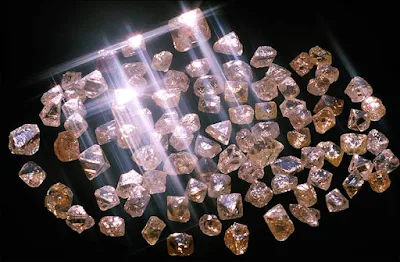New Perfection Found in Diamonds Created by an Asteroid
 |
| A new perfection found in diamonds created by an asteroid |
A new perfection found in diamonds created by an asteroid in Siberian crater 35 million years ago. The Popigai reserves are enough to keep the planet in diamonds for 3,000 years.
'We and Japanese colleagues have arrived at very interesting conclusions,' said Nikolai Pokhilenko, director of the Sobolev Geology and Mineralogy Institute of the Siberian Branch of the Russian Academy of Sciences, reported Interfax.
Their 'high abrasiveness' is 50% to 60% superior to natural or synthetic diamonds, he said.
The impact diamonds from the crater also have exclusive polishing characteristics. 'It is possible to make ideally smooth surfaces. Even nano-size crystals of a regular diamond scratch surfaces, but these diamonds polish so well that you won't see any scratches even with an electronic microscope,' he revealed.
This bodes well for potential applications in high-precision optical systems in satellites, jewellery and other industries, new composite materials, borers and cutting tools, Pokhilenko said.
Further studies of the impact diamonds from the vast site - with reserves 10 times bigger than the world's known diamonds - will continue in cooperation with the Kyiv Institute of Super-Solid Materials, Alrosa's subsidiary Almazy Anabara and De Beers' synthetic diamond subsidiary Element Six, and Baker Hughes.
'The scope of diamond use in industries is growing rapidly in contrast to rare earths, the consumption of which is growing 10-15% per annum,' he said.
'The output of synthetic diamonds has reached 14 billion carats and the new materials (impact diamonds) have their own niche and will eventually force out synthetic diamonds because they are more efficient.'
The precious stones were created by the impact of a space projectile crashed into the Earth 35million years ago, leaving the 100km wide crater.
'The first results of research were sufficient to talk about a possible overturn of the entire world market of diamonds', said the scientist a year ago.
The crater is located above the Arctic Circle northeast of the most northern Russian city of Norilsk. The nearest stepping off point is the outpost of Khatanga from where it is accessible by helicopter.
The Popigai crater is an icon to paleontologists and geologists. But for decades the region was 'off limits' due to diamond mines constructed by Stalin's gulag prisoners. Designated a Geopark by UNESCO, it was created by either an 8 km (5.0 mile) diameter chondrite asteroid, or a 5 km (3.1 mile) diameter stony asteroid, say experts.
Graphite in the ground was instantly transformed into diamonds over a vast territory. Several scientific expeditions to the crater in the 1990s furthered understanding of its origins and potential wealth. Originally, the crater was believed to be volcanic.


%20(1).webp)





